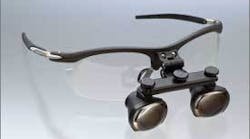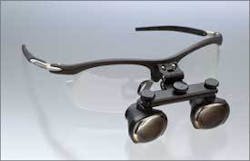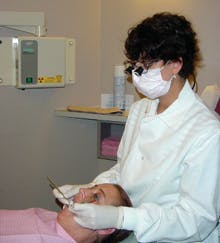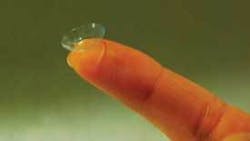by Lynn Pencek, RDH, MS
Surgical telescopes and loupes have become the standard of care in dental hygiene with benefits in both vision and posture. Proper use of loupes not only enhances visual acuity, but also relieves occupational pain caused by cumulative micro-traumas by correcting poor posture during patient care.
Accurate vision is essential for dental hygiene practice. Clinicians find that leaning close to patients enhances visual acuity, but this also results in eye and muscular fatigue. By midlife, clinicians are distressed at their loss of acuity. Compromised vision can lead to misdiagnosis and poor work performance.
Many clinicians now rely on magnification to reduce eye fatigue and enhance visual acuity. One of the biggest benefits of magnification loupes is that, when properly designed, they promote healthy ergonomic posture, reducing neck and back strain.
Much attention has been given to choosing the proper working distance of loupes. Telescopes are designed to work in ranges. The designed working distance of a loupe can be affected by the effect (or omission) of the user’s optical prescription.
When purchasing loupes, clinicians should be questioned about their last eye exam and whether they should install a correction. Those purchasing loupes are often not aware that they may require corrective lenses, and vanity may inhibit some from seeking visual correction. Many can’t recall the date of their last eye exam. If a prescription is needed and excluded, the loupes may not function properly and cause headaches.
Why is it important to have biannual eye exams?
Similar to instructing patients to have regular dental hygiene visits, people are strongly encouraged to receive biannual eye exams. Diseases of the eye are most often painless. An eye doctor can also diagnose other health issues by examining the eye. Common conditions diagnosed by eye doctors include diabetes, high blood pressure, and glaucoma.
How does the eye work?
The eye functions similar to a camera for image formation. With a camera, light rays penetrate the lens and form an image projected onto film. The film captures the projected image, and when developed, allows us to see the picture.
In the eye, image formation occurs with the cornea and lens. Exposure control for brightness, or the aperture of the camera, is in the iris and pupil. The photo receptor or detection, the film of the camera, is received by the retina using the rods and cones. The processing or developing is performed by the optic nerve and brain. If any of these components function poorly, a poor picture is the result.
When ordering loupes, it is important to understand your visual needs for the configuration of the loupes. It is the loupe manufacturer’s job to properly configure the loupe to meet your needs. The purchaser plays the important role of providing the correct information to the manufacturer to help determine the lens configuration.
Definition of visual terms
For clarification, vision can be defined in three terms: close, intermediate, and distance. Close vision (reading) is used for reading charts and viewing the oral cavity. Intermediate vision (arm’s distance and longer) includes viewing items on the instrument tray, X-ray monitors, rheostats, and computer screens. Distance vision involves items on the far side of the room such as clocks, silent communication systems, and more.
Emmetropia is normal vision, and 20/20 is the term used to rate and measure normal vision. With 20/20 vision, the normal population can read the smallest line on an eye chart from 20 feet. With 20/40 vision, the normal population can read from 40 feet. With 20/10 vision, the normal population can read from 10 feet. If you have normal vision, a “plano” lens or no correction is installed in the lens of the loupe system.
Astigmatism is common in people who need to wear vision correction all the time. The lens or cornea with a more elliptical than round shape causes astigmatism. The cornea has an error in shape that prevents the light from focusing correctly on the retina. The bending of light causes the image to be blurred in the direction of the nonspherical area. To correct astigmatism, a cylinder prescription is needed to converge light in one plane. With astigmatism, the correction should be installed in the loupe system.
The most common visual correction is for myopia, or nearsightedness, and a correction is necessary to see far away. This condition is caused by an eyeball diameter that is too long, which causes light rays to focus in front of the retina. When a person is nearsighted, near items are in focus and far items are blurry. To correct myopia, a minus prescription is needed to decrease refractive power of the eye, which moves the focal point onto the retina. If you need to wear a corrective lens to see distances, you probably do not need to install this correction in your loupe system. However, if you wear glasses for everyday function, you should install the correction in your loupes.
Hyperopia, or farsightedness, requires a correction to see up close. This is caused by an eyeball shape that is too short, so that light rays focus behind the retina. Far objects are in focus and near objects are blurry. To correct hyperopia, a plus (+) prescription is needed to increase the refractive power of the eye. It is not uncommon for people with this condition to install their correction in the carrier lens.
Presbyopia is a common condition known as “over-40 eyes,” because it typically occurs after age 40. Presbyopia calls for one prescription to see far away and a different prescription to see up close. There is a normal loss of accommodation due to hardening of the lens of the eye. The eye lens loses its ability to change shape for correct focusing of light when viewing up close. To correct presbyopia, a plus (+) prescription is combined with another or with just plano to be used when viewing up close. If you wear reading glasses, you can split your correction for distance and near viewing with a cut lens or bifocal. For people who remove their glasses for reading, a frequently used option is installing the reading correction in the telescopes and retaining the carrier lens in the loupe for distance.
As the lens of the eye loses elasticity, the loss of near vision increases. With time, it is common for the presbyoptic to get stronger reading glasses by increasing their add (+) correction. The stronger the add (+), the shorter the working distance. This transfers with the use of loupes. Someone may order loupes to focus at 18 inches, and increase his or her reading prescription from +1.00 to +2.50 for everyday use. If the prescription is not also changed in the loupes, they will focus farther than 18 inches until the reading add (+) is increased in the loupe to shorten its working distance.
A clinical example of this is the operator who was able to sit up comfortably to view the patient when ordering his or her telescopes. Five years down the road the operator’s reading prescription increases from +1.00 to +2.00. This means the reading add (+) needs to be increased in the telescope or the working distance of the loupe will lengthen, causing the operator to lean backward away from the patient. After the telescope reading add (+) is increased, the working distance will shorten to the proper working distance and allow the operator to resume the correct working distance and posture originally ordered.
Accommodation is the involuntary process of the lens adjusting its shape to focus when looking at close objects to distant objects and back. In youth, the lens of the eye is very flexible and visual acuity enhances with bringing an item closer to the eye. During midlife, the eye’s lens loses elasticity, and people may experience loss of near vision. Use of a reading correction or an add (+) helps in viewing items at close range. Loss of accommodation or presbyopia can be corrected in a variety of ways.
Methods of vision correction
Eyeglasses are commonly used for vision correction. Contact lenses may be worn as an alternative to eyeglasses. Contact lenses are a semipermeable membrane placed directly on the eye to correct poor vision without eyeglasses. When purchasing loupes, contact lens wearers are considered 20/20 and require no prescription, unless the wearer is presbyopic and needs reading glasses in addition to the contact lenses. When manufacturing loupes for a contact lens wearer who needs reading glasses, an add (+) prescription should be included in the loupe to establish the correct working distance. The carrier lens can be left plano for distance.
Methods in vision correction for presbyopia
Reading glasses can be worn to correct hyperopia to create 20/20 distance without a correction, and the reading add (+) gives accommodation for near vision. This can occur for both normal vision and the contact lens wearer. Reading glasses are typically rectangular and worn below the pupil to allow distance viewing over the corrective lens.
Bifocal glasses are a two-lens system with both distance and near vision correction in the lens. The distance correction is installed in the top of the lens above the line, and the reading correction is typically cut to be worn below the pupil to allow viewing of close objects. Blended bifocal has the classic distance on top and the reading correction in the lower lens configuration, which has the line removed or “blended” so that the lenses do not appear to have bifocals.
Mono vision contacts are a new trend for both contact lenses and laser surgery correction. One eye is corrected for distance, and the other for near vision. Typically the dominant eye is used for distance, and the nondominant eye is corrected for up close. The use of mono vision is well received by some, while others have difficulty using a dominant eye or with the alteration to depth perception.
When manufacturing loupes for mono vision, an add (+) prescription should be included in the loupe over the eye corrected for distance to correct to 20/20 up-close vision. The carrier lens should be left plano for the side corrected for close vision. This will correct both eyes for close vision, and leave the distance eye able to view distance when not looking through the loupe.
New to the market, bifocal contacts are weighted contacts with dedicated areas of the lens to correct for distance and close vision. Some people have experienced success with these lenses; however, this writer has observed that many people do not have success with these lenses for clinical dental hygiene. If you wear a bifocal contact lens and want to purchase loupes, some people have had success putting a plano lens in the loupe system. This writer has observed success for loupe uses with standard single-vision contact lenses and reading prescriptions installed in the loupe system.
Laser surgery is also available for vision correction, but not everyone is a good candidate for it. If you are a candidate, you will not need to install a correction in your loupe system after you have laser surgery, unless you need a near correction for presbyopia. If this is the case, you will need to install the Add in your telescope system. Also, not all procedures are completely successful and may require wearing some version of correction after the surgery.
It is important to understand your visual needs when ordering a magnification system to ensure proper lens correction configuration and proper working distance. It is also important to obtain regular eye exams and periodically change the prescription in the loupes to ensure proper eye health, working distance, posture, and function of the loupes.
References
• American Ophthalmologists Association, www.aoa.org
• American Optometrists Association, www.assoc-optometrists.org
• Ergosonics.com
Angular and Linear Magnification
Single plane magnifiers, such as reading glasses, are linear magnification, which is the process of bringing an image physically closer or shortening the working distance. Linear magnification is defined in terms of plus (or +). With linear magnification, the stronger the power, the closer the working distance.
It is common for eye doctors to over prescribe reading glasses to give extra linear magnification to clinicians instead of loupes. The theory sounds like a good and inexpensive way of providing magnification, but the result is a shortened working distance. The clinician leans forward to accommodate a stronger prescription, resulting in musculoskeletal micro-traumas.
Loupes are compound lens magnifiers that provide angular magnification. Loupes provide longer healthier working distances. Angular magnification is defined in terms of power (X). With angular magnification, the image is physically enlarged and the working distance can be set to a desirable longer, healthier distance.
Magnification Myths
It is common over years for a presbyoptic person to require stronger reading magnification to aid in the loss of accommodation due to age. There is a myth that your eyes will get weaker from using magnification; in reality this is a normal unavoidable aging process.
Magnification and Power
It is possible for a presbyoptic loupe user to wear a 2.5x magnifier with a +2.50 prescription installed. The +2.50 prescription is the reading correction for vision at reading distances, and the 2.5X loupe enlarges the images to two and a half times.
Lynn Pencek, RDH, MS, began practicing with loupes and speaking about them in 1993. She published her first article about magnification and dental hygiene practice in 1997. Lynn currently works full time with KERR/Orascoptic in sales and consultation for dentists and hygienists on ergonomics and the use of loupes. She can be reached at [email protected].










